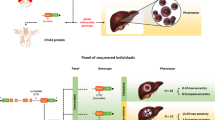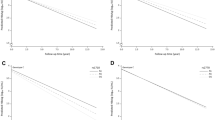Abstract
Although most hepatitis C virus (HCV)-infected individuals develop chronic infection, about 25% of them are able to clear the virus spontaneously without any therapeutic intervention. The aim of the present study was to identify genes associated with spontaneous HCV clearance in a population of Iranian patients. We genotyped 110 single-nucleotide polymorphisms (SNPs) in 59 selected—candidate—genes in a cohort of 107 HCV-infected participants who spontaneously cleared the infection and 176 participants whose infection persisted. Three out of the 110 SNPs were found to be associated with HCV outcome (P-values<0.03). rs11506105 in EGFR (epidermal growth factor receptor gene), and rs11881222 and rs12979860 in IL28B (interferon-λ3 gene). Multivariate logistic regression of the three markers showed that the A/A genotypes in both rs11506105 (EFGR) and rs11881222 (IL28B), and the C/C genotype in rs12979860 (IL28B) are associated with HCV clearance (recessive model: odds ratio (OR)=2.06, 95% confidence interval (95% CI)=1.09–3.88, P=0.025; OR=2.09, 95% CI=1.23–3.60, P=0.007; and OR=1.95, 95% CI=1.15–3.35, P=0.014 for rs11506105, rs12979860 and rs11881222, respectively). In conclusion, EGFR and IL28B SNPs are strong independent predictive markers of spontaneous viral clearance.
This is a preview of subscription content, access via your institution
Access options
Subscribe to this journal
Receive 6 digital issues and online access to articles
$119.00 per year
only $19.83 per issue
Buy this article
- Purchase on Springer Link
- Instant access to full article PDF
Prices may be subject to local taxes which are calculated during checkout
Similar content being viewed by others
References
Shepard CW, Finelli L, Alter MJ . Global epidemiology of hepatitis C virus infection. Lancet Infect Dis 2005; 5: 558–567.
Micallef JM, Kaldor JM, Dore GJ . Spontaneous viral clearance following acute hepatitis C infection: a systematic review of longitudinal studies. J Viral Hepat 2006; 13: 34–41.
Merat S, Poustchi H . Hepatitis C in Iran. How extensive of a problem is it? Arch Iran Med 2012; 15: 268.
Poustchi H, Esmaili S, Mohamadkhani A, Nikmahzar A, Pourshams A, Sepanlou SG et al. The impact of illicit drug use on spontaneous hepatitis C clearance: experience from a large cohort population study. PLoS One 2011; 6: e23830.
Rauch A, Gaudieri S, Thio C, Bochud PY . Host genetic determinants of spontaneous hepatitis C clearance. Pharmacogenomics 2009; 10: 1819–1837.
Thio CL . Host genetic factors and antiviral immune responses to hepatitis C virus. Clin Liver Dis 2008; 12: 713–726 xi.
Yee LJ . Host genetic determinants in hepatitis C virus infection. Genes Immunity 2004; 5: 237–245.
Khakoo SI, Thio CL, Martin MP, Brooks CR, Gao X, Astemborski J et al. HLA and NK cell inhibitory receptor genes in resolving hepatitis C virus infection. Science 2004; 305: 872–874.
Knapp S, Yee LJ, Frodsham AJ, Hennig BJ, Hellier S, Zhang L et al. Polymorphisms in interferon-induced genes and the outcome of hepatitis C virus infection: roles of MxA, OAS-1 and PKR. Genes Immunity 2003; 4: 411–419.
Prokunina-Olsson L, Muchmore B, Tang W, Pfeiffer RM, Park H, Dickensheets H et al. A variant upstream of IFNL3 (IL28B) creating a new interferon gene IFNL4 is associated with impaired clearance of hepatitis C virus. Nat Genet 2013; 45: 164–171.
Mosbruger TL, Duggal P, Goedert JJ, Kirk GD, Hoots WK, Tobler LH et al. Large-scale candidate gene analysis of spontaneous clearance of hepatitis C virus. J Infect Dis 2010; 201: 1371–1380.
Thomas DL, Thio CL, Martin MP, Qi Y, Ge D, O'Huigin C et al. Genetic variation in IL28B and spontaneous clearance of hepatitis C virus. Nature 2009; 461: 798–801.
Tillmann HL, Thompson AJ, Patel K, Wiese M, Tenckhoff H, Nischalke HD et al. A polymorphism near IL28B is associated with spontaneous clearance of acute hepatitis C virus and jaundice. Gastroenterology 2010; 139: 1586–1592 e1.
Rehermann B, Nascimbeni M . Immunology of hepatitis B virus and hepatitis C virus infection. Nat Rev Immunol 2005; 5: 215–229.
Rao HY, Sun DG, Yang RF, Liu F, Wang J, Feng B et al. Outcome of hepatitis C virus infection in Chinese paid plasma donors: a 12-19-year cohort study. J Gastroenterol Hepatol 2012; 27: 526–532.
Wang CC, Krantz E, Klarquist J, Krows M, McBride L, Scott EP et al. Acute hepatitis C in a contemporary US cohort: modes of acquisition and factors influencing viral clearance. J Infect Dis 2007; 196: 1474–1482.
Grebely J, Page K, Sacks-Davis R, van der Loeff MS, Rice TM, Bruneau J et al. The effects of female sex, viral genotype, and IL28B genotype on spontaneous clearance of acute hepatitis C virus infection. Hepatology 2014; 59: 109–120.
Thompson AJ, Muir AJ, Sulkowski MS, Ge D, Fellay J, Shianna KV et al. Interleukin-28B polymorphism improves viral kinetics and is the strongest pretreatment predictor of sustained virologic response in genotype 1 hepatitis C virus. Gastroenterology 2010; 139: 120–129 e18.
Shi X, Pan Y, Wang M, Wang D, Li W, Jiang T et al. IL28B genetic variation is associated with spontaneous clearance of hepatitis C virus, treatment response, serum IL-28B levels in Chinese population. PLoS One 2012; 7: e37054.
Bibert S, Roger T, Calandra T, Bochud M, Cerny A, Semmo N et al. IL28B expression depends on a novel TT/-G polymorphism which improves HCV clearance prediction. J Exp Med 2013; 210: 1109–1116.
McFarland AP, Horner SM, Jarret A, Joslyn RC, Bindewald E, Shapiro BA et al. The favorable IFNL3 genotype escapes mRNA decay mediated by AU-rich elements and hepatitis C virus-induced microRNAs. Nat Immunol 2014; 15: 72–79.
Schneider MR, Wolf E . The epidermal growth factor receptor ligands at a glance. J Cell Physiol 2009; 218: 460–466.
Lupberger J, Zeisel MB, Xiao F, Thumann C, Fofana I, Zona L et al. EGFR and EphA2 are host factors for hepatitis C virus entry and possible targets for antiviral therapy. Nat Med 2011; 17: 589–595.
Scheel TK, Rice CM . Understanding the hepatitis C virus life cycle paves the way for highly effective therapies. Nat Med 2013; 19: 837–849.
Shepherd FA, Rodrigues Pereira J, Ciuleanu T, Tan EH, Hirsh V, Thongprasert S et al. Erlotinib in previously treated non-small-cell lung cancer. N Engl J Med 2005; 353: 123–132.
Pourshams A, Khademi H, Malekshah AF, Islami F, Nouraei M, Sadjadi AR et al. Cohort Profile: The Golestan Cohort Study—a prospective study of oesophageal cancer in northern Iran. Int J Epidemiol 2010; 39: 52–59.
Purcell S, Neale B, Todd-Brown K, Thomas L, Ferreira MA, Bender D et al. PLINK: a tool set for whole-genome association and population-based linkage analyses. Am J Hum Genet 2007; 81: 559–575.
Acknowledgements
This work was supported by funds from the Strasbourg High Throughput Next Generation Sequencing facility (GENOMAX), INSERM UMR_S 1109 and Agence Nationale de la Recherche, Programme Blanc ANR-07-BLAN-0108 entitled GENHEPC and Institut de Recherche pour le Développement (IRD). Our laboratory was further supported by the Institut Universitaire de France (IUF), the Partenariat Hubert Curien GUNDISHAPUR by the ministères des Affaires étrangères et du développement international (MAEDI) and Enseignement supérieur et de la Recherche (MESR), the Institut de Recherche pour le développement (IRD) and the Centre National pour la Recherche Scientifique (CNRS). This work was additionally supported by Tehran University of Medical Sciences and in part by the intramural research program of the Division of Cancer Epidemiology and Genetics, National Cancer Institute.
Author information
Authors and Affiliations
Corresponding authors
Ethics declarations
Competing interests
The authors declare no conflict of interest.
Additional information
Supplementary Information accompanies this paper on Genes and Immunity website
Supplementary information
Rights and permissions
About this article
Cite this article
Carapito, R., Poustchi, H., Kwemou, M. et al. Polymorphisms in EGFR and IL28B are associated with spontaneous clearance in an HCV-infected iranian population. Genes Immun 16, 514–518 (2015). https://doi.org/10.1038/gene.2015.38
Received:
Revised:
Accepted:
Published:
Issue Date:
DOI: https://doi.org/10.1038/gene.2015.38
This article is cited by
-
Correlation between IL-28 polymorphism and spontaneous clearance in HCV patients: systematic review and meta-analysis
Archives of Virology (2021)
-
EGFR rs11506105 and IFNL3 SNPs but not rs8099917 are strongly associated with treatment responses in Iranian patients with chronic hepatitis C
Genes & Immunity (2017)



